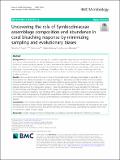Uncovering the role of Symbiodiniaceae assemblage composition and abundance in coral bleaching response by minimizing sampling and evolutionary biases
Author(s)
Swain, Timothy D.; Lax, Simon; Backman, Vadim; Marcelino, Luisa A.
Download12866_2020_Article_1765.pdf (3.184Mb)
Publisher with Creative Commons License
Publisher with Creative Commons License
Creative Commons Attribution
Terms of use
Metadata
Show full item recordAbstract
Background: Biodiversity and productivity of coral-reef ecosystems depend upon reef-building corals and their associations with endosymbiotic Symbiodiniaceae, which offer diverse functional capabilities to their hosts. The number of unique symbiotic partners (richness) and relative abundances (evenness) have been hypothesized to affect host response to climate change induced thermal stress. Symbiodiniaceae assemblages with many unique phylotypes may provide greater physiological flexibility or form less stable symbioses; assemblages with low abundance phylotypes may allow corals to retain thermotolerant symbionts or represent associations with less-suitable symbionts. Results:
Here we demonstrate that true richness of Symbiodiniaceae phylotype assemblages is generally not discoverable from direct enumeration of unique phylotypes in association records and that cross host-species comparisons are biased by sampling and evolutionary patterns among species. These biases can be minimized through rarefaction of richness (rarefied-richness) and evenness (Probability of Interspecific Encounter, PIE), and analyses that account for phylogenetic patterns. These standardized metrics were calculated for individual Symbiodiniaceae assemblages composed of 377 unique ITS2 phylotypes associated with 123 coral species. Rarefied-richness minimized correlations with sampling effort, while maintaining important underlying characteristics across host bathymetry and geography. Phylogenetic comparative methods reveal significant increases in coral bleaching and mortality associated with increasing Symbiodiniaceae assemblage richness and evenness at the level of host species. Conclusions: These results indicate that the potential flexibility afforded by assemblages characterized by many phylotypes present at similar relative abundances does not result in decreased bleaching risk and point to the need to characterize the overall functional and genetic diversity of Symbiodiniaceae assemblages to quantify their effect on host fitness under climate change.
Date issued
2020-05Department
Massachusetts Institute of Technology. Department of PhysicsJournal
BMC Microbiology
Publisher
Springer Science and Business Media LLC
Citation
Swain, Timothy D. "Uncovering the role of Symbiodiniaceae assemblage composition and abundance in coral bleaching response by minimizing sampling and evolutionary biases." BMC Microbiology 20, 1 (May 2019): 124 © 2020 Springer Nature
Version: Final published version
ISSN
1471-2180